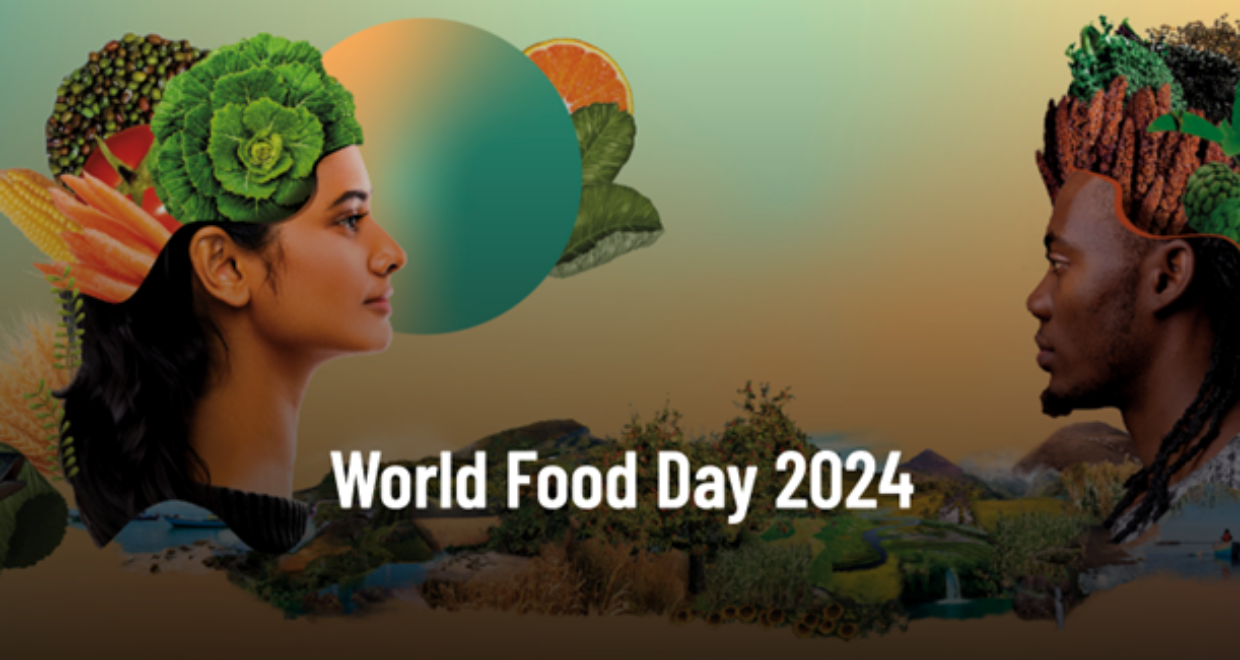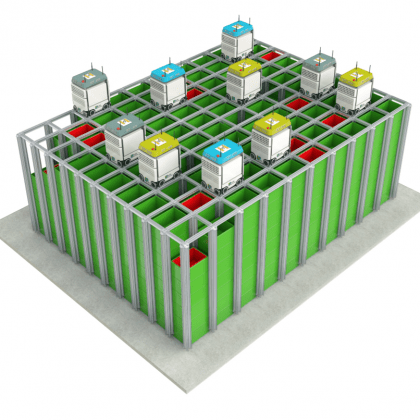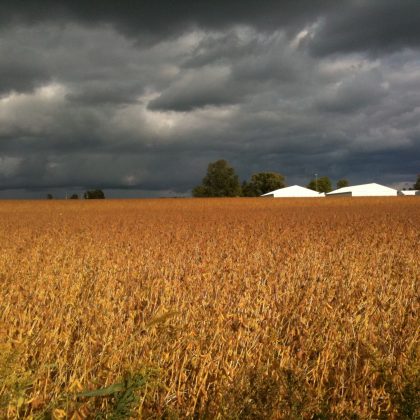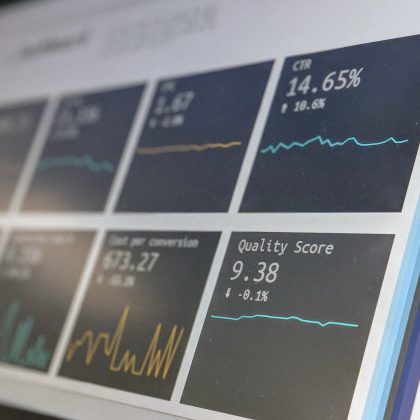Transforming Agrifood Systems: Celebrating World Food Day and Our Right to Foods for a Better Future
October 16th is World Food Day, commemorating the 1945 founding of the United Nations Food and Agriculture Organization (FAO). The Day also aims to raise awareness around the foundational issues impacting poverty and hunger around the world. Associated events include World Food Day Sunday Dinners, Food Expos, Farmers’ and Fishermans’ Workshops, and many more at the local, regional, national, and international levels.
The FAO’s 2024 World Food Day theme is “Right to foods for a better life and a better future.” They define foods as including dimensions of diversity, nutrition, affordability, accessibility, and safety, emphasizing that humans have a basic right to food that meets all these priorities. Transforming agrifood systems is a major strategy to begin better meeting humanity’s basic right to foods around the world, with great potential to mitigate climate change and support peaceful, resilient, and inclusive livelihoods for all.
The FAO specifically calls for massive investment in innovation, science, technology, and collaborative efforts between actors including governments, the private sector, academic and research institutions, and civil society. To find out more about what you can do as a citizen, academic, government or industry employee, and more, visit https://www.fao.org/world-food-day/take-action/en.
To recognize World Food Day, Renewable Agriculture and Food Systems is featuring the following seven articles selected by Editor-in-Chief Katherine Dentzman. These articles cover a wide range of issues including the potential for local producers to supply residents’ vegetable needs, demographic differences related to the availability of short food supply chains and their customers, nutritional and socioeconomic impacts of social gardens,
Below, we provide citations, links, and a brief description of each article. We encourage you to pick at least one that interests you and read it in more depth in honor of World Food Day. May we all work together towards a better food future.
Stone, T.F., J.R. Thompson, E. Zimmerman, T.M. Brighenti, & M. Liebman. 2024. What would it look like? Visualizing a future US Corn Belt landscape with more table food production. Renewable Agriculture and Food Systems 39, e5.
- This study employs land visualization and survey data to explore the potential for greater local table food production to support sustainable and resilient communities in the US Corn Belt.
- They found that just 3% of currently available agricultural land, if converted to table food production, could provide up to 25% of residents’ fruit, vegetable, and grain needs. Producers did have plans to expand their table food production, but cited food safety regulations, labor concerns, crop insurance, and lack of processing facilities as major barriers.
Trivette, S. & S. McCarragher. 2024. Who’s near the local food? A regional proximity analysis of short food supply chain types in southern New England. Renewable Agriculture and Food Systems 39, e6.
- Trivette and McCarragher investigate Short Food Supply Chains in southern New England, linking a typology of these supply chains to the dominant demographic characteristics of the areas in which they operate. Specifically, they employ geolocations of locally-oriented farms, choropleth mapping, and sociodemographic data to determine accessibility of pay-as-you-go, CSA box share, farmstands, and other supply chain formats.
- Findings indicate that pay-as-you-go operations tend to exist in more predominantly White areas with higher overall incomes, while CSA box shares are likely to be located in communities with higher educational attainment. It is hypothesized that CSAs are linked to higher levels of educational and cultural capital, suggesting that class differences are key to understanding access.
Maró, Z.M., G. Maró, Z. Jámbor, P. Czine, & Á. Török. 2023. Profiling the consumers of farmers’ markets: a systematic review of survey-based empirical evidence. Renewable Agriculture and Food Systems 38, e53.
- Maró et al. conduct a review of survey-based empirical studies describing the sociographic, economic, environmental, and social parameters that characterize consumers of farmers’ markets in 21 countries.
- They find that consumers of farmers’ markets are largely homogenous, with only minor variation due to regional specificities. Typically, consumers were female, middle-aged, Caucasian, well-educated, and high income (unless in a developing country or participating in a government-supported program). Most consumers also lived in urban areas, visited farmers’ markets located in their hometown, had small family sizes, and were interested in organic and chemical-free foods for taste and health reasons. The study concludes with some recommendations for growing the diversity of consumers of farmers’ markets.
Baldi, A., N.L. Gallo, & A. Lenzi. 2024. Productive function of urban gardening: estimate of the yield and nutritional value of social gardens in Prato (Italy). Renewable Agriculture and Food Systems 39,e4.
- This study reports on semi-structured interviews conducted in social gardens in Prato, Italy. Social gardens are areas of land assigned by municipalities to pensioners and unemployed persons for the cultivation of vegetable for domestic consumption. The authors explored production and nutrition outcomes as well as socioeconomic and demographic characteristics of social garden participants.
- They found that social gardeners tended to be male and retired, with an average age of 74 and a low level of education. Benefits of participation included increased physical activity and socialization as well as self-esteem. These gardens typically produced 61.5% of an individual’s yearly fruit and vegetable needs, but could easily be enhanced with training programs oriented towards vegetable composition, nutrition, and efficient agricultural practices.
Tran, L., McCann, L., & Su, Y. 2023.Consumer preferences for produce grown with reduced pesticides: a choice experiment in Missouri. Renewable Agriculture and Food Systems 2023 38(e49)
- Tran and colleagues report on the results of a survey of fresh tomato consumers in Missouri, examining their preference for reduced pesticide, organic, and local produce.
- Findings indicate that respondents were willing to pay 6% more for tomatoes produced with 50% less pesticides, but overall preferred organic tomatoes. However, preference shifted to tomatoes produced with 50% less pesticides when these tomatoes were also marketed as local or Missouri Grown. Consumers also preferred tomatoes produced by family farms compared to corporations. These findings suggest that reduced pesticides combined with a local production designation may provide a compromise between conventional and organic production; the authors encourage the development of a reduced pesticide label.
Sabio, R.P., Lehoux, P., & Rastoin, J.L. 2023. Characterizing food systems to better understand their vulnerabilities: a case study in Québec and São Paulo. Renewable Agriculture and Food Systems 38(e25)
- This study describes the organizational features of food systems in Québec and São Paulo to better understand structural vulnerabilities that limit sustainability and food security. Secondary data analysis of data from government and non-government sources were used to identify major patterns.
- Shared vulnerabilities in both food systems included 1) interdependence with other countries due to export-oriented supply chains and foreign labor with major external risks; 2) concentration on a few major products (i.e. livestock in Québec and sugarcane in São Paulo) to the exclusion of more resilient diverse food systems; and 3) unequal power relations putting small and medium players at risk. In line with a neoliberal food regime, economic goals predominated above sustainability and food security.






